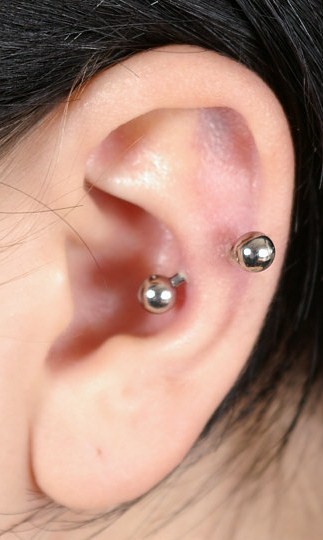Navigating body piercings safely
West End Healthline
By Lydia Tortorici, MD
Piercings for decorative, religious, spiritual, and cultural purposes have been used for thousands of years. Given their current surge in popularity, here is some important information you should know before getting one.
Most common piercing locations: Ear: lobes, helix cartilage, tragus; Nose: septum or nostril; Navel (belly button); Nipple.
Is getting a piercing safe?
Yes, piercing is safe if done correctly. Risks include minor localized infections, improper placement or poor healing causing cosmetic damage. These risks can be minimized by good piercing technique, but the piercing industry is not well-regulated. Different states and individual businesses will have different standards for training, cleanliness and jewelry quality. The best way to ensure a piercing salon is adequately trained in good technique and cleanliness is to check if they are members of the Association of Professional Piercers (APP). The APP has established standardized minimum guidelines for safe piercing that is required for all members.
Choosing the right jewelry
When choosing jewelry for a piercing, the two main things to think about are material and fit. Your body will swell around your new piercing, so piercers may initially put a looser piece of jewelry in to accommodate swelling and later exchange it with a more fitted piece. This is to avoid loose jewelry that may snag, migrate, or cause irritation and prolonged swelling.
Metals used in jewelry should be approved by the American Society for Testing and Materials Standards or International Standards Organization, to ensure appropriate quality and safety. Metals not approved for use in jewelry run the risk of causing allergic or irritating reactions, discoloration or infection. Keep a record of the jewelry material as this may matter should you need medical imaging (CT scan, MRI scan) in the future.
Some examples of commonly used safe jewelry materials: ASTM F138 Steel (often contains surgical-grade nickel) , ASTM F136 Titanium, Niobium, Gold (14k or higher solid gold or gold-plating are not suitable for initial piercings), Platinum, Certain types of glass.
What can go wrong?
This list is not exhaustive, but here are some of the more common issues experienced with piercings:
Rejection: There is always a possibility that your body will reject a piercing, pushing the jewelry out over time like a splinter. Some of the more common rejection sites are eyebrow, belly button, surface piercings, hip piercings. Excessive movement of the jewelry or mechanical stress on the piercing site increase the chances of rejection. Signs of rejection include jewelry looking like it’s moved or gotten “shallow”, chronic irritation, or skin changes around the piercing (flaking, thinning, etc).
Infection: Infection risk is primarily from contamination by bacteria that already live on your skin or by spread of hardy viruses like Hepatitis B and C. Risks of infection are greatly mitigated by appropriate sterilization of jewelry and equipment used and with attentive aftercare. Infections can become serious if you have a medical condition which causes immunosuppression, such as lupus or diabetes. If you have a heart condition, especially a history of endocarditis (infection in the heart) or a valve replacement, talk to your doctor before getting a new piercing. Such conditions should not necessarily prohibit piercings, but should be discussed beforehand so the piercing client knows what to expect and can make an informed decision.
Scarring: Some amount of scarring is inevitable with piercings, but snagging or excessive moving of the jewelry during healing can cause temporary “bumps” to form next to piercings during healing. Folks with a genetic predisposition to excessive scarring, such as people who form keloids (excessive fibrous tissue with wound healing), are more likely to have unsightly scars after a piercing is inserted or removed. Depending on the severity and type of the scar as well as the individual’s desire to change it, changes in aftercare and at-home treatments may be sufficient. Keloid scarring should be assessed by a medical professional.
Difficult removal: Jewelry, especially during the initial swelling period, if not fitted properly, or in people who form scars/keloids, is at risk of your skin growing over it. Jewelry placed by piercing guns is much more likely to become embedded as it is often one-size-fits-all and the technique of piercing causes more swelling afterward. Surface piercings, where there is jewelry placed under the skin which the outside gem attaches to, may have particularly difficult removals if placed incorrectly or the outside gem becomes lost.
Improper placement or unsuited anatomy: If piercings aren’t performed by an experienced or trained piercer, the piercing may look “off” due to being placed improperly. This is not a medical risk generally, but since we often get piercings for cosmetic reasons, this is a universally unwanted outcome of a piercing. Piercings performed on unsuited anatomy can lead to chronic irritation, delayed or impossible healing, and excessive scar tissue.
Piercing location-specific complications: Some tongue piercing placements, ill-fitting jewelry, or excessive play with the piercing can cause dental damage and/or gum erosion. Healing ear piercings can cause discomfort when laid on and can interfere with sleep. Nipple piercings can sometimes affect breastfeeding. Some genital piercings run the risk of making barrier contraception (condoms and dental dams) less effective, persistent erections or change in sensation.
Can I safely pierce myself or my friend?
In short, no. In addition to the risks associated with using non-sterile equipment and jewelry, piercings by untrained practitioners can result in longer term complications such as poor healing, excessive scarring and aesthetically unpleasing placements.
Do I see my doctor or my piercer to check on my jewelry?
If you are experiencing signs of an infection, such as excessive or discolored discharge, radiating redness or heat from the piercing site or a sudden fever, see a doctor immediately. Typically if there is an infection present, jewelry should not be removed as piercings are draining wounds and allowing the piercing to close could lead to abscess. If you suspect there’s a problem with your jewelry, such as it being too tight or too loose, or if you need it removed, contact your piercer. Professional piercers can help troubleshoot most piercing problems and in some cases it may be most helpful to have the input of both a piercer and a medical professional.
Dr. Tortorici is a family physician at Allina Health United Family Physicians, 233 Grand Ave, Saint Paul, MN 55102; 651-241-5200. Dr. Tortorici thanks Jasper Zephyr, an APP-certified piercer who proofread and edited this article.




